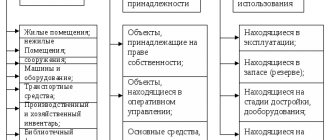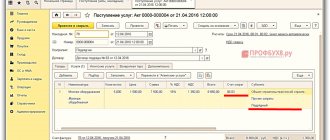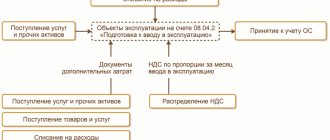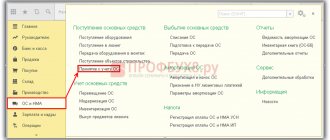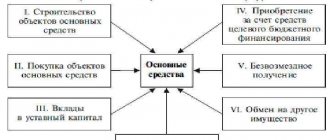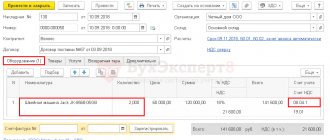Each company strives to take into account the costs incurred for the purchase or creation of non-current assets when calculating income tax. However, for one category of property, a one-time write-off of the full cost of the object is allowed, while for another, attribution to costs is carried out gradually. Tax law establishes a minimum value of assets, which makes it possible to classify them as fixed assets. At the same time, the approved limit on fixed assets in 2021 has not changed. For the purposes of recognizing company property in accounting as subject to depreciation, its value must, in accordance with the requirements of PBU 6/01, exceed 40 thousand rubles.
Limit on the value of fixed assets in 2021: accounting
All criteria for compliance of a non-current asset with the standards defined by PBU must be achieved in the organization’s accounting. Thus, assets with a useful life exceeding one year and acquired not for resale should be classified as fixed assets. One of the important indicators that allows not so much to include property in the fixed assets, but to ensure the systematic write-off of its value using the depreciation method, is the limit on the value of fixed assets (no changes in 2021).
Based on PBU 6/01, fixed assets include non-current assets with a value exceeding 40 thousand rubles. As a result, all objects, the acquisition costs of which do not exceed the specified amount, are included in the inventory and are subject to attribution to expenses at a time.
IFRS IAS 16 General information
The international financial reporting standard IAS 16 was developed to reliably and consistently produce internal corporate accounting of property, plant and equipment and reflect this data in financial statements.
In turn, sections of financial statements that are devoted to fixed assets enable interested parties from among shareholders and users of IFRS to find comprehensive information about the state of the enterprise in terms of long-term assets, the size of investments in fixed assets, changes in the composition of such investments, as well as issues of their carrying value, depreciation and impairment losses.
Figure 1. An example of a statement of financial position in the software product “WA: Financier” (fragment): fixed assets.
For any owner or investor, information of this nature is extremely important, since without it not only forecasts of the financial prospects of the business are impossible, but also the operational improvement of the company’s efficiency, which today comes to the fore in matters of the company’s competitiveness in the market.
The standard is required to be applied by all companies that maintain accounting in accordance with the requirements of international financial practice for all types and types of fixed assets, except those that would contradict another standard. As an example, we can recall assets that a company initially acquires not for use in its business, but in order to make money on the resale of such assets: a segment of such assets will not be recognized and accounted for under IFRS 16, like some others: for example, those related to agriculture and minerals.
Limit of fixed assets in 2021: tax accounting
Unlike accounting for accounting purposes, tax accounting contains other requirements for limiting the value of fixed assets. Since 01/01/2016, Russian taxpayers have been given the opportunity to take into account assets in NU as an object of accumulation of depreciation with a value of 100 thousand rubles. and higher. Consequently, in tax accounting, assets worth up to 100 thousand rubles, which organizations and entrepreneurs include in the inventory, require immediate write-off. This requirement is relevant only for those operating systems that were accepted for accounting after 01/01/2016.
How did the limits on fixed assets objects adopted in National Accounting and Accounting affect accounting? Mainly, the resulting discrepancy contributes to the appearance of temporary differences. The problem is connected precisely with the accounting of inexpensive objects, which, starting from 2021, are written off differently in these accounting systems. The methodology for calculating income tax involves reflecting temporary differences in the accounting accounts. Until the end of the useful life of the organization, a deferred tax liability arises, listed in the account of the same name 77.
Increasing the limit on the value of fixed assets in tax accounting contributes to the accelerated write-off of the value of the asset, thereby reducing the tax burden when calculating income tax. However, the need to reflect temporary differences in accounting causes many difficulties for accountants.
Criteria for recognizing an asset as an item of fixed assets
Issues of correct reflection in accounting of transactions related to fixed assets concern accountants of organizations in almost any field of activity. A new interpretation of the concept of “fixed assets” is contained in the Instructions for accounting of fixed assets, approved by Resolution of the Ministry of Finance of the Republic of Belarus dated April 30, 2012 No. 26 (hereinafter referred to as Instruction No. 26).
However, when reflecting individual business transactions in the accounting accounts, the standards of other regulatory legal acts on accounting should be applied - Instructions for accounting of investment real estate and Instructions for accounting of long-term assets intended for sale, approved by the resolution of the Ministry of Finance of the Republic of Belarus dated April 30, 2012 No. 25.
According to paragraph 4 of Instruction No. 26, when accepting assets for accounting as fixed assets, the following conditions must be simultaneously met :
a) assets are intended for use in the production of products, when performing work or providing services, for use in auxiliary, service industries and farms, for the management needs of the organization or for provision by the organization for a fee for temporary possession and use or for temporary use;
b) assets are intended to be used for a period exceeding 12 months;
c) the assets are not intended at the time of acquisition for subsequent resale;
d) the historical cost of assets can be reliably determined;
e) assets are capable of bringing economic benefits (income) to the organization in the future.
In Belarusian practice in recent years, there was another condition for recognizing an asset as a fixed asset - cost. It was 30 basic units. Meanwhile, international accounting standards do not have a cost criterion for accepting fixed assets for accounting.
Organizations have the right to introduce this additional criterion when recognizing an object as a fixed asset. At the same time, the order on accounting policies should justify the feasibility of introducing such a rule.
The accounting unit of fixed assets is an inventory object, which is recognized as an object with all fixtures and accessories, or a separate structurally isolated object intended to perform certain independent functions, or a separate complex of structurally articulated objects, representing a single whole and intended to perform a specific job. A complex of structurally articulated objects is one or more objects of the same or different purposes, having common devices and accessories, common control, mounted on the same foundation, as a result of which each object included in the complex can perform its functions only as part of the complex, and not independently.
So, for example, personal computers can be accounted for in account 01 “Fixed Assets” either as a single object or as an object consisting of several inventory objects (system unit, monitor, etc.). The computer can also be counted together with software devices. At the same time, the useful life of these assets must coincide.
But if the periods of their use are different, PCs are taken into account separately from program control devices in account 01 “Fixed Assets”, and the software product can be taken into account
or on account 04 “Intangible assets” as the exclusive copyright to a computer software product,
or to account 97 “Deferred expenses” in case of acquiring the right to use computer programs and databases under contracts with the copyright holder (under agreements), including costs for updating computer programs and databases.
When purchasing a property , it should be taken into account that that are not executed by acceptance certificates and other documents (including documents confirming state registration of real estate in cases established by law) cannot be included in fixed assets.
Acceptance of an object for real estate accounting depends on who owns the ownership. A real estate property, the ownership of which is not registered in the prescribed manner, cannot be accepted for accounting as an object of fixed assets. Until the registration of ownership, this property must be accounted for in account 08 “Investments in non-current assets”.
When determining the composition and grouping of fixed assets, it is necessary to be guided by Resolution of the Ministry of Economy of the Republic of Belarus dated September 30, 2012 No. 161 “On establishing standard service lives of fixed assets and invalidating certain resolutions of the Ministry of Economy of the Republic of Belarus” (hereinafter referred to as Resolution No. 161).
| NOTE! In relation to fixed assets accepted for accounting before January 1, 2012, it is possible to apply the classification of fixed assets based on Resolution No. 161 or preserve the codes and regulatory deadlines previously established by organizations, adopted on the basis of Resolution of the Ministry of Economy of the Republic of Belarus dated November 21, 2001 No. 186 “ On approval of the Temporary Republican Classifier of depreciable fixed assets and their standard service life." This norm is established in subparagraph. 2.1 clause 2 of resolution No. 161. |
According to clauses 5-6 of Instruction No. 26 for fixed assets as a set of material assets used as means of labor in the production of products, performance of work or provision of services, or for managing an organization for a period exceeding 12 months, or the normal operating cycle, if it exceeds 12 months, includes buildings, structures, working and power machines and equipment, measuring and control instruments and devices, computer equipment, vehicles, tools, production and household equipment and supplies, working and productive livestock, perennial plantings, on-farm roads etc.
Land plots and environmental management facilities (water, subsoil and other natural resources) are also taken into account separately as part of fixed assets, since depreciation is not accrued for these fixed assets.
They also include capital investments in radical land improvement (drainage, irrigation and other reclamation works) and in leased fixed assets (inseparable improvements, added value, etc.). Completed capital investments in leased fixed assets are credited by the lessee organization to its own fixed assets in the amount of actual costs incurred, unless otherwise provided by the lease agreement.
At the same time, fixed assets received for rent are accounted for in off-balance sheet account 001 “Leased fixed assets”, and leased own fixed assets can be accounted for (in accordance with the accounting policy) in account 01 “Fixed assets” or account 03 “Income-generating investments in material assets”. assets" separate sub-account (investment real estate, other income-generating assets).
Capital investments in perennial plantings and radical land improvement are included in fixed assets annually in the amount of costs related to the areas accepted for operation in the reporting year, regardless of the completion date of the entire complex of work.
If one object has several parts that have different useful lives, each such part is accounted for as an independent inventory item.
For example, an organization has built an industrial building that has its own mini-transformer station to ensure uninterrupted power supply and specially equipped storage facilities equipped with electronic sensors to maintain the same humidity and temperature in the room.
The act of commissioning a fixed asset object was issued alone for the production complex, since individually these objects do not function independently.
To properly organize the accounting of these objects, the accountant should indicate “industrial complex” in the fixed asset inventory card and note that the complex consists of several objects and each object is assigned an individual inventory number and a different code for depreciation rates and useful lives is used.
| NOTE! Separately (on sub-accounts), organizations include as part of fixed assets objects that are not involved in the production of products, goods, works, services and are not used in the management of the enterprise. These are non-production facilities and housing stock. For such objects, the accounting policy describes a special procedure for calculating depreciation (wear and tear) and the procedure for accounting for income from their use (rent, sale of vouchers and coursework, food coupons, etc.). |
Unfair actions of financiers in working with fixed assets
Company property is often the object of various abuses by managers or a tool through which creditors, investors or company owners can be misled:
- The most common phenomenon at the small level is private theft, which leads to distortion of data on the company’s balance sheets, when in fact there is no property, but on paper it creates an asset.
- The second most common violation is in the area of asset disposal, when unscrupulous financiers appropriate property for themselves, excluding it from the company’s fixed assets before the appointed time. For example, small equipment such as computers or office equipment, equipment that can be used in everyday life, and other material assets are fictitiously written off according to documents as “end-of-life” assets, but in fact they are simply taken for themselves or sold on the open market with serious dumping.
- The third method, which mainly affects creditors and shareholders, is the determination of an incorrect actual value of an asset, which “embellishes” the company’s property position contrary to reality.
- In fourth place are abuses, which are expressed in the company’s failure to receive the actual amount of compensation when selling an asset leaving the company at a reduced price in exchange for personal kickbacks for the company’s managers.
A well-built internal control system and accounting system, built on standardized principles, can eliminate any of the types of abuse described above when working with assets.
Disclosure of information according to IFRS IAS 16 Fixed Assets
The IFRS IAS 16 Fixed Assets standard establishes requirements for the disclosure of information in the field of fixed assets by asset class of an enterprise. According to the methodological recommendations, the company is obliged to disclose reliable information that will help users of financial statements to consider the issue of fixed assets of the enterprise as fully as possible, containing:
- Justification of the basis that the company uses when assessing the carrying value of assets;
- Disclosure of information about the chosen depreciation method;
- Terms of effective use fixed and justified in the accounting policy;
- Approved norms and amounts of actual depreciation;
- Classified carrying amounts and amounts of accumulated depreciation, including losses from loss of carrying value at the beginning and end of the period.
In addition, financial statements must provide users with reliable information:
- On the presence of restrictions on the ownership rights of the company’s assets;
- If fixed assets were transferred as a guarantee to secure obligations;
- About the amount of costs and their classification, which are included in the book value of the asset at the construction/installation stage;
- The amounts of the company's liabilities that were assumed to acquire fixed assets;
- Amounts of compensation that were transferred to third parties in connection with the loss or depreciation of assets.
According to IFRS IAS 16 Property, Plant and Equipment, it is also useful for a wide range of users of a company’s financial statements to disclose additional information that allows them to assess the financial potential of the company:
- Book values and fair values of assets not in temporary use;
- Book values of assets that are fully depreciated;
- The book values of assets that are no longer effectively used, but will not be sold by the company on the market.
Figure 6. Example of consolidated statements. Statement of comprehensive income (fragment) in the software product “WA: Financier”: depreciation of fixed assets is included in the cost of sales.
